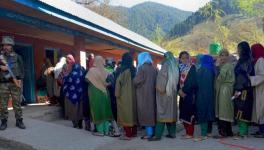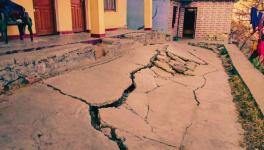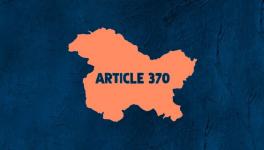Why Hydropower is a Pipe Dream in Kashmir’s Development
Image for representational use only.Image Courtesy : Wikimedia Commons
Following abrogation of the special status of Jammu and Kashmir (J&K), and to stem accusations of human rights abuses in the Kashmir Valley, the central government is preparing an economic package for the region in the hope that it will mute a growing tide of criticism. In focus is the fast-tracking of 33 hydroelectric projects along the Chenab, Jhelum and Ravi rivers.
In his first term, Prime Minister Narendra Modi had reportedly said that blood and water cannot flow together. His remark was seen as raising the issue of the Indus Water Treaty, a 1960 pact on sharing the waters of rivers that flow between India and Pakistan. The indirect questions started being raised after the Uri attack in 2016. Recently, minister of Jal Shakti, Gajendra Singh Shekhawat, also said that the process to stop the waters of the Chenab, Jhelum and Ravi from flowing into Pakistan has started. To this remark, he added, “I am talking about the water which is going to Pakistan, I am not talking about breaking the Indus Water Treaty.”
Shekhawat said he had ordered officials in his ministry to expedite the hydrological and techno-feasibility studies of these rivers so that excess water flows can be diverted to Rajasthan, Punjab and J&K. “I have given [a] direction that it should be done promptly so that we can execute our plans,” he said. And yet, over the last two weeks, more than two lakh cusecs of water have flowed downstream to Pakistan following the release of excess water from the Bhakra Dam, said the Bhakra Beas Management Board chairman, DR Sharma.
Pakistan has responded to this release with the claim they were not informed about it. The chairman of Pakistan’s Water and Power Development Authority, Muzammil Hussain, recently said, “India was using its upstream position to wage a fifth-generation warfare on our country.”
This sequence of events is linked to the hydropower projects that India is pushing in the Valley, and which will be directly monitored by the Prime Minister’s Office (PMO). The Bursa project, which is expected to generate 800 MW, and the Sawalkot project that will generate 1,856 MW, are among these. Detailed Project Reports have been prepared for both projects. The Sawalkot project, which will be the largest hydro-project in the Valley, was cleared by the environment ministry’s Expert Appraisal Committee for River Valley and Hydroelectric Projects in 2018.
While the Indus Treaty allows India to use 3.6 million acres feet (MAF) water for storage facilities, Pakistan cannot prevent the construction of the Sawalkot dam. Yet, this has not stopped Pakistan from expressing its apprehensions over the construction. Pakistan is convinced that these new dams will affect downstream water flow. India, on the other side, believes it is well within its rights to use the excess water.
Other projects in the pipeline in J&K and Punjab are the Shahpur Kandi project on the Ravi river in Gurdaspur, which is meant to utilise water leaving the powerhouse of the Thein Dam, to irrigate 37,173 hectares in both states and generate 206 MW power. The Ujh Multipurpose Project will create storage of about 750 cubic metres water on the river Ujh, a tributary of the Ravi, again for irrigation and power-generation. The second Ravi-Beas link, located below Ujh, is meant to tap the excess water flowing to Pakistan through the Ravi. This will be done by constructing a barrage across the Ravi, from where water will be diverted through a tunnel and linked to the Beas basin.
Also being accorded top priority is the Tulbul navigation project comprising a 40-foot-wide barrage on the Jhelum, which is meant to aid transport of commodities from Srinagar and Baramula. Work on it started in 1984 but was suspended in 1987 after Pakistan claimed that it violated the Indus Water Treaty. Following the Uri attacks, India is determined to resume work on it despite Pakistan’s objections.
Uttam Sinha, a research fellow at the Institute for Defence Studies and Analyses (IDSA), who wrote the book, Riverine Neighbourhood and Hydro Politics, believes that the present government considers riverine systems an important thrust area. “The situation has altered after [the] Uri [attack],” says Sinha. “Today, the government is determined to use water to integrate Kashmir into the country,” he says.
The cost of these projects is, however, prohibitive. This is obvious from the fact that the central government, despite claiming that it is eager to push riverine navigation, actually cut the budget of riverine navigation projects substantially in the current budget. Nevertheless, Sinha is confident that with the central bank’s transfer of Rs1.76 lakh crore to the Centre, a substantive allocation for these projects, which are also of great strategic value, will be made.
Sinha has been intensively researching the first Prime Minister Jawaharlal Nehru’s notes on the Indus Water Treaty and has simultaneously been working closely with the PMO on water issues. “Kashmir is top priority for the central government,” he says. “If it can come up with a sustainable plan, it will send the right message to the Kashmiri people,” he says.
That said, the power generation problem is more complex than it appears. According to Sinha, Kashmir has the potential to generate 16,000 MW of electricity but has been able to generate only 3,000 MW a year. Besides, Kashmir receives only 20% of the electricity it generates. The remaining 80% is sent to Punjab, Himachal Pradesh and Delhi.
In 2017, the State (J&K) Economic Survey estimated that Kashmir could produce 20,000 MW hydropower of which 16,475 MW has been identified. The problem is that most of the current hydroenergy projects, such as Salal, Uri, Dul Hasti, Sewa-2, Uri-2 and Kishanganga are being run by the National Hydro Power Corporation (NHPC) which allots J&K only 12% share of this capacity. The NHPC is blamed for power shortages in Kashmir and locals derisively refer to it as the “New East India Company.” The J&K State Power Development Corporation does not have the resources to undertake any of these mega projects.
Not just that. Environmentalists view plans to construct massive dams with suspicion. For one, these will involve large-scale destruction of forest cover and equally tremendous displacement. Moreover, the Sawalkot project is being constructed in an earthquake-prone zone, where a number of quakes have already been recorded.
Himanshu Thakkar, coordinator of the South Asia Network on Dams, Rivers and People, has a more fundamental critique of this large network of dams being built in J&K. “Large hydroprojects are no longer economically viable,” he says. “Private players who had invested in J&K and Himachal Pradesh are all keen to surrender their projects as they do not find them viable,” he says.
According to Thakkar, the cost of generating electricity in such plants ranges from Rs 7-8 per unit, “but the electricity tariffs actually being charged are much lower.” He cites the Kishanganga hydroelectric project to illustrate this point. “Every megawatt of electricity costs the public exchequer Rs10 crore. This means that the NTPC must sell electricity at around Rs10 per unit to recover costs but the present electricity tariffs are between Rs 3-4 per unit. It is, therefore, a hugely loss-making enterprise.”
If India’s dam construction spree in J&K is of concern to environmentalists, the Chinese construction of the gigantic Bhasha and Bunji dams on the Indus river in Gilgit-Balistan, in North Pakistan is ringing alarm bells amongst South Block mandarins in Delhi. Bhasha is expected to produce 4,500 MW of electricity and is the highest dam of its kind—a roller-compacted concrete gravity dam—anywhere in the world. The Bunji Dam on the Indus will produce 7,100 MW electricity, to be sent to China. The cost of these dams will cross $50 billion and they are a part of China’s One Belt One Road initiative.
In any case, water experts are not convinced that now is the time for India to be talking up abrogation of the Indus Treaty. As water expert and physicist Vikram Soni says, “China is the big elephant in the room. It is also building several dams on the Brahmaputra which should be of great concern to India. Abrogation of Article 370 has already pushed us to the wall. We are hardly in a position to handle worsening of relations with Pakistan by triggering a war over water.”
India’s plans pale into insignificance before the sheer scale of China’s efforts. This is one reason why water experts are calling for the adoption of a river basin approach to water management in India. The idea is that all the nations (Nepal, Bhutan, China and Bangladesh) through which rivers flow in South Asia should participate in discussions on water sharing.
Rashme Sehgal is a freelance journalist. Views are personal.
Get the latest reports & analysis with people's perspective on Protests, movements & deep analytical videos, discussions of the current affairs in your Telegram app. Subscribe to NewsClick's Telegram channel & get Real-Time updates on stories, as they get published on our website.
























